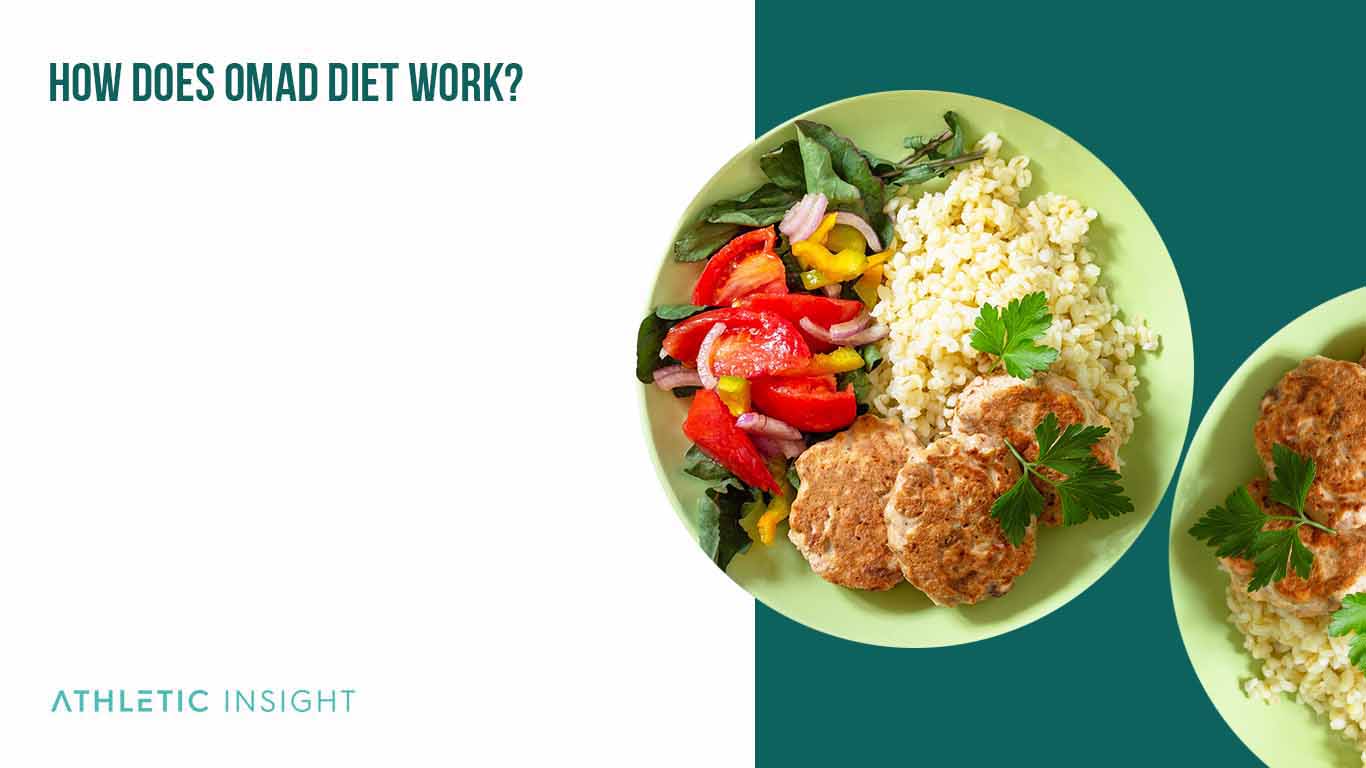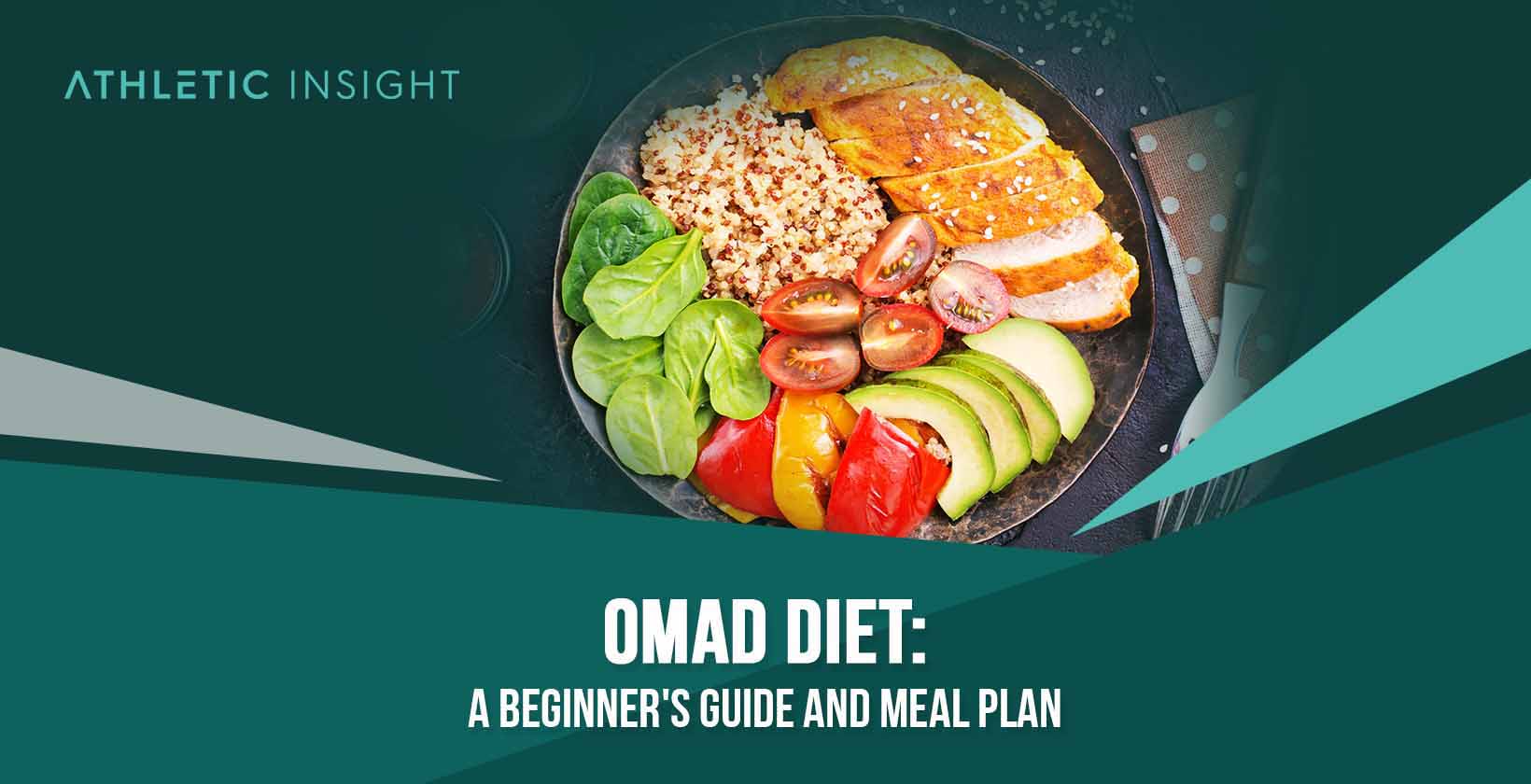The one-meal-a-day (OMAD) diet is an intermittent fasting plan that aims to target the body’s fat stores during the fasting period. The OMAD diet has an individual eating one meal a day, consuming all necessary calories during one big meal, and fasting during the other hours of the day and night.
The importance of OMAD diet is changing how the body uses fat, carbohydrates, and protein. Intermittent fasting changes the body to use ketogenesis, which converts protein and fat into energy (instead of carbs).
The benefits of using the OMAD diet are that it can help people who are extremely overweight lose weight and fat in a short time period. In addition, the OMAD diet can help boost productivity, lessen reliance on food, and allow the body to burn more fat stores.
A person can begin the OMAD diet by slowly eating healthier over time. Once they have cut out all processed foods and excess sugars, they can start to eat one meal per day. The person should focus on eating whole foods, ample protein, and healthy fats during their one meal per day in the one-hour window.
Other popular variations of the OMAD diet in today’s culture include Ketomad (ketogenic meal that is high in fat, moderate in protein, and low in carbohydrates), Carbomad (one meal a day with varying carbohydrate levels), and Zeromad (one meal per day that is very high in protein).
How Does the OMAD Diet Work?
The OMAD diet is when a person only eats one meal daily within one hour. A person following the diet must consume all their required OMAD diet calories daily within that one meal. This is also considering a time restricted diet.

The body’s initial reaction to the OMAD diet is extreme hunger and potential tiredness. Since most people are used to eating at least three meals per day, with some people eating snacks in between meals, eating only once daily will challenge the body to use energy stores throughout the day.
The body may respond negatively at the beginning of the OMAD diet, with some people experiencing extreme hunger, weakness, low energy, and trouble focusing. However, people who continue using the OMAD diet will eventually become used to the once-a-day eating schedule. Studies have shown that people who fast for 18-20 hours per day can help with managing stress, controlling glucose levels, and lowering diabetes risks.
Eating only once daily helps boost productivity, facilitate weight loss, burn body fat, and eat (almost) whatever you want with very few nutritional restrictions. The optimal time to schedule an OMAD diet meal is usually in the middle of the day to break up the long fasting period.
The OMAD diet encourages people to eat a high-fat diet, allowing the body to slowly transition from high levels of carbohydrates to using fat and protein as the primary energy source. The OMAD diet affects the organs, digestive hormones, and metabolism.
How Often Should You Eat in an OMAD Diet?
A person following the OMAD diet should eat only once per day.
What Are the Health Benefits of the OMAD Diet?
There are numerous OMAD diet side effects and benefits such as heart health, reduction of cancer risk, preventing type 2 diabetes, lowering blood pressure, decreases asthma symptoms, and promotes bone health.

- Heart health with OMAD diet: The OMAD diet helps reduce the number of LDL cholesterol and triglycerides in the blood. In addition, fasting helps reduce systolic blood pressure.
- Reduces cancer risk: Fasting can help lower glucose levels, which makes it more difficult for various types of cancer to grow.
- Prevents type 2 diabetes: Many people use the OMAD diet for weight loss. The OMAD diet helps reduce insulin resistance, boost insulin sensitivity, and lowers glucose levels.
- Lowers blood pressure: The OMAD diet helps lower blood pressure levels since intermittent fasting can benefit the gut bacteria and microbiome.
- Decreases asthma symptoms: Intermittent fasting has been shown to help asthmatic patients reduce inflammation, lower their body weight, and manage asthma symptoms.
- Promotes bone health: Intermittent fasting through the OMAD diet helps prevent osteoporosis and bone breakdown as individuals age. Fasting can help produce the human growth hormone, which makes muscles and bones stronger. It can also reduce the likelihood of developing osteomyelitis in the bones and bloodstream (a disease that transmits pathogens between the bones and the blood).
What Are the Health Risks of the OMAD Diet?
There are a few key health risks to keep in mind before beginning the OMAD diet such as stroke risks, cholesterol levels, and higher insulin.
- Stroke risk: Eating one meal daily puts people at a higher risk of developing diabetes or stroke.
- Cholesterol levels: Eating one meal per day increases a person’s risk of increased LDL and high-density cholesterol levels.
- Higher insulin: Eating one time per day causes an increase in insulin and a decrease in metabolism.
How To Do an OMAD Diet?
Before you start the OMAD diet schedule, you need to know a few basic facts to stay healthy and reap the proposed benefits. Someone thinking of starting the fasting diet should consume the necessary number of calories per day to reach their goals. If you consider losing weight during the OMAD diet, you should aim for a daily calorie deficit.
The best way to find out the number of calories to consume is to calculate your basal metabolic rate and your energy expenditure. As a rough guideline, a person doing the OMAD diet should consume between 1,500 and 2,000 calories per meal, depending on their activity level, goals, body weight, size, and muscle mass.
The proposed time frame for the OMAD diet is a one-hour eating window for at least one week. After you have completed the OMAD diet for a shorter time frame, most people will increase their OMAD fasting window to between 6 and 12 weeks.
For individuals who drastically need to lose weight or alter their health outlook, using the OMAD diet for 12-24 weeks is more beneficial. Below is a list of the best practices to successfully follow an OMAD diet.
- Start slow: The best way to begin an OMAD diet is to start slow and transition from a healthy diet to a fasting diet. Instead of going from eating in excess every single meal to just one meal per day, slowly changing your eating habits before beginning intermittent fasting can make the change less drastic.
- Time your meals: Timing your meals at a similar window every single day can help you build a routine and stay consistent over time.
- Eat enough protein: When you are only eating one meal per day, you need to eat enough protein to maintain muscle mass and avoid losing your hard-earned workout gains. Plus, eating protein is very filling and can help you feel full and satiated for the entirety of your fasting window.
- Drink less caffeine: Consuming less caffeine during an OMAD diet can help present cortisol spikes and higher stress levels.
What Are the Foods That You Can Eat While on an OMAD Diet?
There are specific foods that are beneficial to eat while on an OMAD diet. Below is a list of the best items in each food group for an OMAD diet meal plan.
- Fruits: Grapes, watermelon, pineapple, mango
- Vegetables: Cauliflower, broccoli, spinach, sweet potato, bell peppers, lettuce, turnip, beetroot, cabbage, carrot, kale
- Grains: Wheat, brown rice, black rice, quinoa, barley, millet, sorghum
- Legumes: Peas, lentils, beans
- Nuts: Peanut butter, sunflower butter, almond butter
- Seeds: Cashews, hemp seed oil
- Healthy fats: Full-fat milk, full-fat yogurt, cheddar cheese, cottage cheese, buttermilk, coconut oil
- Proteins: Egg whites, fish, pork, beef, chicken breast
What Are the Foods That You Should Avoid While on an OMAD Diet?
During fasting, you should focus on eating high-calorie foods with low carbohydrate levels — this will help transition your body to burn fat, instead of carbs, as an energy source. Individuals should avoid specific foods while following an effective OMAD diet.
- Meat: Fatty slices of meat, such as fatty beef, bacon, and pork
- Poultry: Turkey
- Fish and shellfish: Fried fish, canned fish with high sodium levels
- Meat-based ingredients: Processed meats
- Eggs: Egg Yolk
- Dairy products: Ice Cream
The food choices during your OMAD meal should be whole foods that do not contain any type of excess sugars or processed ingredients. For example, turkey is a type of meat that is higher in sodium and contains high levels of tryptophan — a hormone that makes you tired.
Furthermore, fried fish contain high levels of fat, and canned fish contain high levels of salt, which can reduce the healthiness of your diet. Processed meats have been shown to increase the risk of cardiovascular disease and diabetes. Although soy is a dairy alternative, soy can cause digestive issues and stomach concerns, especially for those with low levels of iodine.
Who Should Do the OMAD Diet?
Individuals who need to lose a significant amount of fat, reduce their type 2 diabetes diagnosis, and lower their risk of heart disease, Alzheimer’s, or Parkinson’s should consider using an OMAD diet. Those who are at risk of an eating disorder, anxious personality disorder, or have a low BMI should not do the OMAD diet.
What Are the Best Recipes for the OMAD Diet?
There are a few very tasty recipes for the OMAD diet that are good for a well-rounded diet.

- Sweet potato sandwich: Use one sweet potato, butter, four eggs, cheese, avocado, and seasoning to make a sweet potato sandwich.
- Chicken with kale crisps and vegetables: Use chicken wings or breasts, pepper, carrots, kale, coconut oil, ginger, turmeric, coriander, onion, and chili pepper to make kale chips with seasoned chicken.
- Eggs with chickpeas: Use eggs as your main protein source, combined with avocado for healthy fats, chickpeas for grains, nutritional yeast, and butter as a hearty breakfast meal.
- Salmon with omelet and asparagus: Combine smoked salmon, two eggs, one avocado, asparagus, and tahini for a filling omelet.
- Smoked fish with sweet potato: Smoke your choice of white fish or salmon with sweet potato, greek yogurt, olive oil, pepper, leafy greens, and canned corn.
What is a Sample OMAD Diet Plan?
Below is a list of a sample OMAD diet plan that includes meat, dairy, vegetables, and fruits.
- Day 1. Ribeye with cheese butter and foie gras
- Day 2. Chicken with kale crisps and vegetables
- Day 3. Sweet potato sandwich
- Day 4. Salmon and eggs with butter, avocado, cantaloupe, and creme fraiche
- Day 5. Pork belly and sweet potatoes with olive oil, creme fraiche, and yogurt
- Day 6. Lamb chops with russet potatoes and asparagus
- Day 7. Tuna with eggs, olive oil, anchovies, and a cup of fruit
What Are the Facts about the OMAD Diet?
One of the most important things to remember about the OMAD diet is that it is low in saturated fat and cholesterol. In addition, there are significant changes that occur during the first week of doing the OMAD diet. You can expect to feel low in energy, dizzy, and nauseous. This is because your body changes to using ketosis for burning fat instead of carbs to use as energy.
The OMAD diet can also be cheaper than a typical eating plan. Since you are only eating one time per day, you can expect to pay around $10 per day for the ingredients. This brings you to approximately $300 per month, but the total can fluctuate based on the type of meat purchased, the ingredients, and eating organically vs. non-organically.
Compared to the Atkins diet, the OMAD diet is more effective at switching your body to ketogenesis to burn fat. As long as you meet your calorie needs during the OMAD diet, you can maintain or lose weight, control blood sugar, and burn fat for fuel.
Lastly, OMAD is one of the most effective diets for weight loss. Intermittent fasting can result in weight loss, although it might not be any more effective than reducing your overall calorie intake to lose weight over time.
When Can You See the Results of the OMAD Diet?
There are many changes in the OMAD diet before and after. Most people see the first changes in two weeks, with noticeable changes occurring 8-12 weeks after the beginning.
However, 12 hours after you begin fasting, your body will switch to ketogenesis and will use your body fat as your main energy source. So, even though you may not see any changes immediately, your body will begin changing within the first day.
What Are the OMAD Diet Results After 1 Week?
The OMAD diet results in 1 week are usually due to the potential caloric restriction and change into ketogenesis. Some very overweight people will lose as much as 5kg in one week, whereas others may see a change of 2kg.
What Are the OMAD Diet Results After 2 Weeks?
After two weeks, most followers of the OMAD diet will see a further change in their weight. A person will begin to see their bodies adjust to the eating plan and the energy levels.
What Are the OMAD Diet Results After 1 Month?
Many individuals will be accustomed to fasting at this point during the OMAD diet. This means that the OMAD diet results in 1 month can include enhanced productivity levels, less reliance on food, and mental toughness.
What Are the OMAD Diet Results After 3 Months?
Most people will see extreme weight loss in 3 months if they are overweight.
Is the OMAD Diet Expensive?
No, the OMAD diet is not expensive if you do not purchase excess food. Since individuals are only eating once per day, they will save money in the grand scheme of things.
Is the OMAD Diet the Best Diet Plan?
The OMAD Diet may lead to weight loss and healthier routines, but it is not considered the best diet plan. Studies suggest restrictive diets, like OMAD, can have negative impacts on metabolic rate, muscle mass, and overall nutrient intake. The potential for inadequate nutrient intake is high given the limited eating window, and such a restrictive pattern can be challenging to adhere to long term, potentially leading to patterns of disordered eating
It’s important to note that the most effective and sustainable diet plans typically involve balanced nutrition and regular physical activity, tailored to an individual’s specific needs and lifestyle. Therefore, while the OMAD diet might be beneficial for some under medical supervision, it’s not universally the best diet plan for everyone.
What Is the Difference Between a Warrior Diet and an OMAD diet?
The difference between the Warrior Diet and the OMAD diet is that the Warrior Diet is when you eat one meal a day, at night, whereas the OMAD diet does not specify which time you should eat your one meal per day. The only OMAD diet rules are eating one meal and eating the one meal at a similar time every day of the week.
What Is the Difference Between Intermittent Fasting and the OMAD diet?
The difference between Intermittent Fasting and the OMAD Diet is the typical length of time that one fasts for. Intermittent fasting is usually a period of not eating for 16 hours and the OMAD diet has a person fast for 23 hours.



